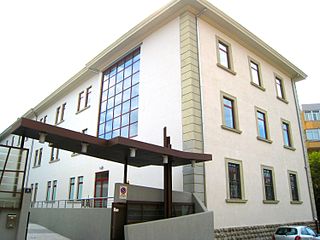
The Palazzo Pitti, in English sometimes called the Pitti Palace, is a vast, mainly Renaissance, palace in Florence, Italy. It is situated on the south side of the River Arno, a short distance from the Ponte Vecchio. The core of the present palazzo dates from 1458 and was originally the town residence of Luca Pitti, an ambitious Florentine banker.

Villa del Poggio Imperiale is a predominantly neoclassical former grand ducal villa in Arcetri, just to the south of Florence in Tuscany, Central Italy. Beginning as a villa of the Baroncelli of Florence, it was seized by the Medici, became the home of a homicidal and unfaithful husband, and a lavish retreat for a Grand Duchess with imperial pretensions. Later given to Napoleon's sister, it was reclaimed by the hereditary rulers of Tuscany before being finally converted to a prestigious girls' school. During its long history, it has often been at the centre of Italy's turbulent history, and has been rebuilt and redesigned many times.
La Società Entomologica Italiana, the Italian Entomological Society, is Italy’s foremost society devoted to the study of insects. The society is famous for promoting applied entomology and many of its past members have saved millions from deadly diseases such as malaria.

Museo Galileo is located in Florence, Italy, in Piazza dei Giudici, along the River Arno and close to the Uffizi Gallery. The museum, dedicated to astronomer and scientist Galileo Galilei, is housed in Palazzo Castellani, an 11th-century building which was then known as the Castello d'Altafronte.

Aristodemo Costoli (1803–1871) was an Italian sculptor who spent his entire career in the city of Florence. He is also known for attempting in 1843 to clean and conserve the famed Renaissance-era sculpture David by Michelangelo; unfortunately his hydrochloric acid cleaning solution removed the stone's waxy protective coating and left the surface pitted and porous. His students included Emilio Zocchi, Girolamo Masini, Augusto Rivalta and his son Leopoldo Costoli.

Ruggero Verity or Roger Verity was an Anglo-Italian entomologist who specialised in butterflies and a physician.

The Orto Botanico di Firenze, also known as the Giardino dei Semplici, the "Garden of simples", is a botanical garden maintained by the University of Florence. It is located at Via Micheli, 3, Florence, Italy, and open weekday mornings.

The Museo di Storia Naturale di Firenze is a natural history museum in 6 major collections, located in Florence, Italy. It is part of the University of Florence. Museum collections are open mornings except Wednesday, and all day Saturday; an admission fee is charged.

Giorgio Jan was an Italian taxonomist, zoologist, botanist, herpetologist, and writer. He is also known as Georg Jan or Georges Jan. He was the first director of the natural history museum at Milan.

The Natural History Museum of the University of Pisa, located in the city of Pisa in Tuscany, Italy, is a renowned institution dedicated to the study and display of natural history. The museum is home to one of the largest collections of cetacean skeletons in Europe, showcasing an impressive array of marine mammal specimens. In addition to its extensive cetacean holdings, the museum's oldest collections include seashells amassed by the Italian invertebrate scientist, Niccolò Gualtieri. Serving as both an educational and research institution, the museum invites visitors and scholars to explore the diversity and complexity of the natural world.

Civico Museo di Storia Naturale di Trieste is a natural history museum in Trieste, northern Italy. It contains several collections, including more than two millions botanical, zoological, mineralogical, geological, and paleontological specimens.

The Natural History Museum in Pavia, Italy is a museum displaying many natural history specimens, located in Palazzo Botta Adorno. Founded in 1775, it was one of the oldest museums of natural history in Europe. It currently forms the University of Pavia museum network, along with 5 other museums — the University History Museum, Museum of Electrical Technology, Museum of Archeology, Museum Camillo Golgi and Museum of Mineralogy.

The University History Museum of the University of Pavia is a museum displaying memorabilia related to the history of the university, particularly in the fields of physics and medicine, when students were taught by prominent scholars such as Antonio Scarpa and Camillo Golgi or the physicist Alessandro Volta.

Gaetano Giulio Zumbo (1656–1701) was an Italian sculptor in wax or wax modeller of the Baroque era. His primary talents were not those generally considered as artistic but devoted to the creation of scientific models that were highly regarded as curiosity pieces in his time. He has also been called an anatomist.

Clemente Michelangelo Susini (1754–1814) was an Italian sculptor who became renowned for his wax anatomical models, vividly and accurately depicting partly dissected corpses. These models were praised by both doctors and artists.

The Academy of Sciences of the Institute of Bologna is an academic society in Bologna, Italy, that was founded in 1690 and prospered in the Age of Enlightenment. Today it is closely associated with the University of Bologna.
The following is a timeline of the history of the city of Florence, Tuscany, Italy.

The Reale Museo di Fisica e Storia Naturale was an Italian museum founded on 22 February 1775 in Florence that survived until 1878, when its collections were split up in various Florentine museums.

















